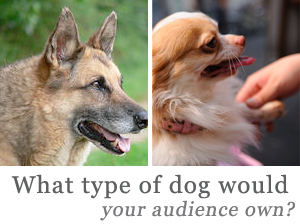If you own an eShop and have little online marketing experience, this guide should help you. I have written five questions you need to ask yourself, each with simple explanations to read and practical examples to follow.
I will be posting each question over the next five days. Please subscribe to ensure you don’t miss out on any advice. Let’s begin!
Day one – ask yourself ‘Do I know my target audience?’
Are you thinking about the people you’re selling to and the people you’d like to sell to? Does your website appeal to their needs? If not, read on:
Why do I need a ‘target audience’?
Competition is fierce and I bet a lot of people sell similar items to your stock.
Let’s pretend you sell a large range of dog toys. A quick Google search indicates 36,400,000 websites currently rank for that term. That’s potentially 36,399,999 other websites that could get that precious sale instead of you.
You need to appeal to one audience to win all of their custom. 
So, let’s find your audience:
Start with what you sell. Ask yourself ‘who needs to buy my product?’ Sticking with my online pet shop analogy, you could say ‘dog owners.’
But be as specific as possible. You can’t target ‘dog owners’ as your audience – it’s too vague.
Drill it down and ‘dog owners’ could be:
Girly owners with cute pooches who dress their beloved pet up in jeweled collars (Think of a Paris Hilton wannabe with her Chihuahua.)
Or –
Serious owners who take their sturdy dogs out on their hardcore walking sessions (Think of a Bear Grylls type with a powerful Alsatian.)
You can already picture the difference in audiences can’t you?
If you’re struggling try to do some research. It’s always good to look at your past customers and work from there. Alternatively, think about the type of person you’d like to buy from your shop in an ideal world.
Next, learn about your audience:
One of the worst things you can do is assume you know everything about your audience.
Get on Twitter or Facebook and interact with them.
Participate on forums that interest your audience to get a feel for what concerns them.
Use everything you gather to build up a persona and use this to help you get a picture of your audience (or who you’d like to be your audience.)
You may wish to draw a picture of a hypothetical member of your audience and write gathered characteristics around the edge of it. Give your doodle a name to really bring it to life.
It’s time to make your website appeal to your audience:
You need to take the plunge and ensure your website appeals to your audience. I’m not suggesting you change your website’s colour scheme or images (though you may wish to consider this later) start small and edit your site’s copy.
Ask yourself:
‘is my copy specific, will it appeal to my audience, or is it too general?’
Start with product descriptions. Don’t stress – you can start small, just think of a couple of lines to describe your products (see my example below.) Write them out while imagining your hypothetical persona. Why would ‘Paris Hilton’ want to buy this dog lead? As you write, imagine you’re explaining the reasons to her. Look at her picture. How would she react to your comments? What would she like/dislike about this lead and why? How can you turn those dislikes into positives?
If you’re worried about changing your copy all at once, test first. You can set up a A/B split test of the old and new copy using Google Website Optimizer and track completed goals (purchases) too. You can see exactly what is working and what isn’t.
Struggling with the copy? Here’s a practical example:
I want to buy my dog a coat. I’m a girly, Paris Hilton type. (For the example’s sake.) I have the same needs as anybody wanting to buy a dog coat: it needs to fit my dog and keep him warm/dry.
I browse two websites to potentially buy from. Both websites tell me the colour and size of each dog coat. Both are equally priced.
But, on the second website there’s a further description, hand written by the shop’s owner, which the first does not have.
“Size Small, Powder Blue. A cute fur-lined jacket to keep your pooch glam and cosy during cold winter walks. ”
Can you see the difference? Both sites give me the same information (size and colour) but the coats on the second website tap into my persona, they tell me my dog will be ‘glam’ and ‘cosy’ too. So I am prone to buy from the second store – it feels like I’m getting more for my money!
Lesson summary:
- Decide on an audience,
- Learn about what drives them,
- Create a typical persona,
- Rewrite your copy to appeal to them, and them only.
Finally, let me know if you have any questions or comments, or to showcase changes you’ve made to your eShop using my techniques. Tune in tomorrow (and for the next three days) for additional techniques to help you improve your online shop!